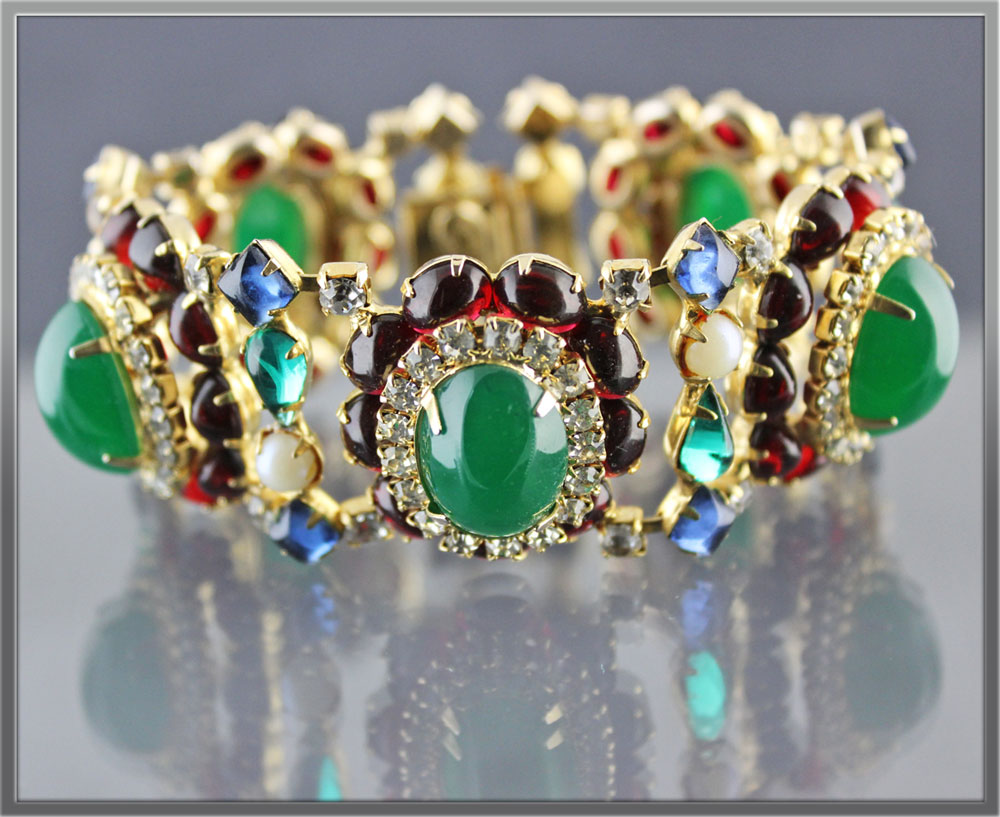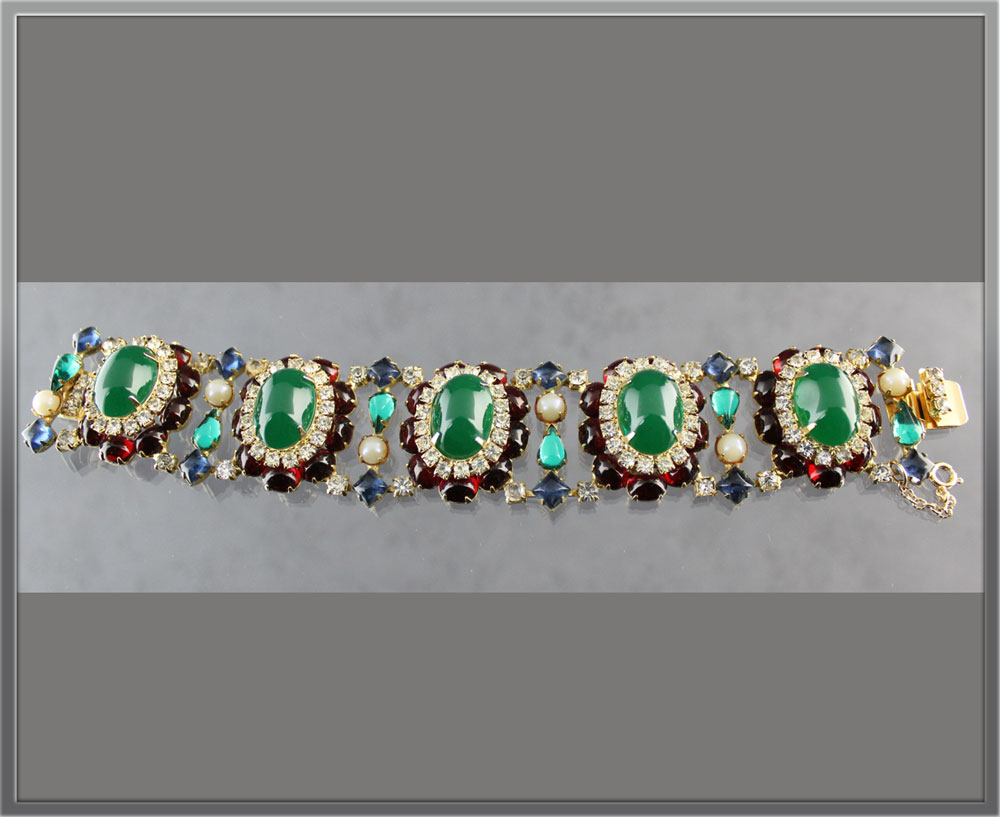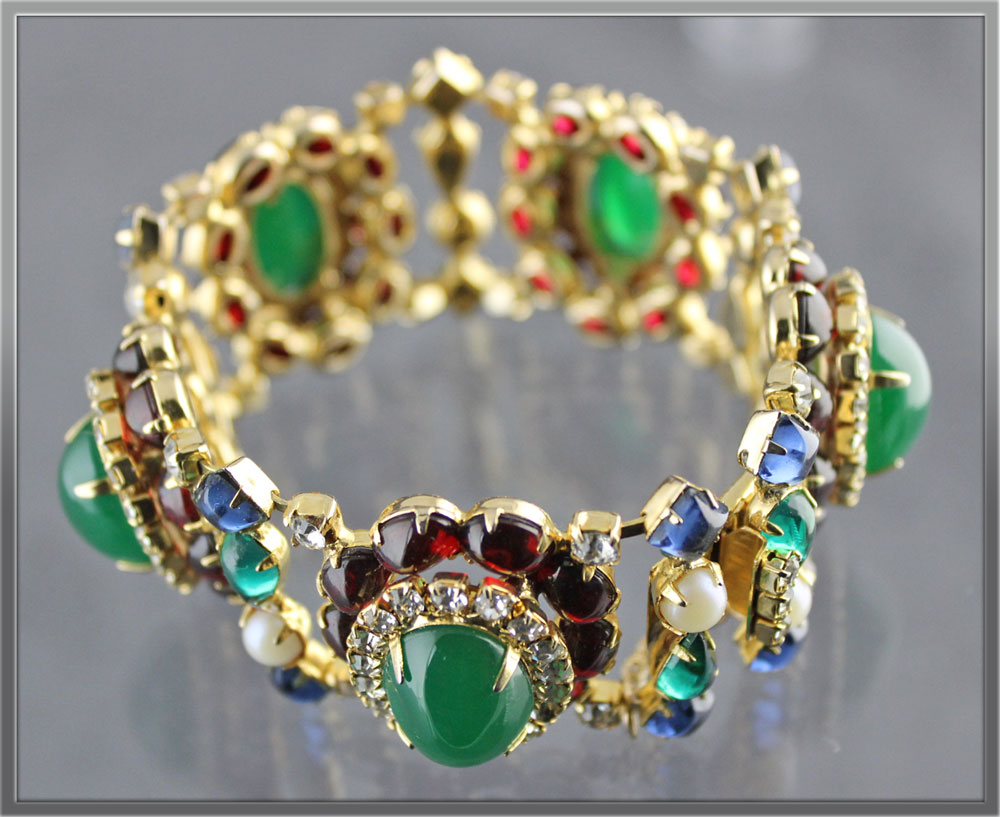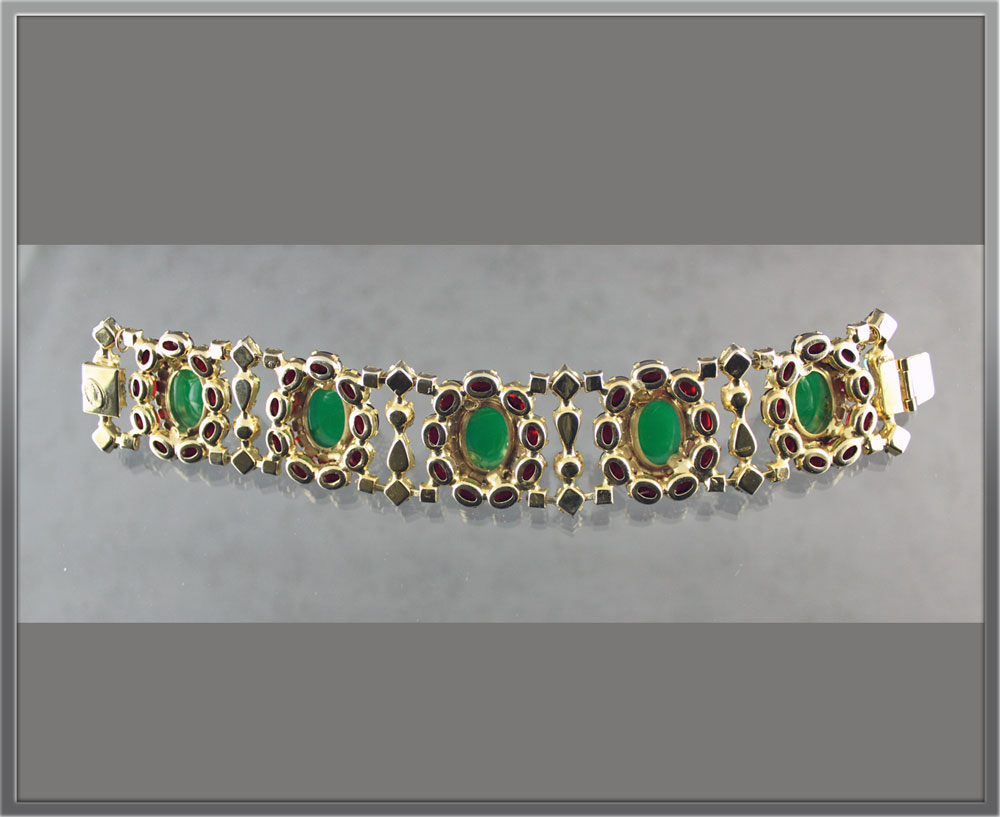Return To Previous Page
Hattie Carnegie | Jewel Tone Moghul Style 5-Link Bracelet
Hattie Carnegie | Jewel Tone Moghul Style 5-Link Bracelet
. . . . Gorgeous!
Carnegie
A beautifully crafted bracelet by Hattie Carnegie. A veritable cornucopia of gem colored cabochons and rhinestones that are fit for a queen. Hattie Carnegie delivered this moghul style bracelet in 4, 5 and 6 link variations. This gold tone bracelet is 5 links with each link holding a huge faux emerald oval cabochon center stage surrounded by clear rhinestone and gorgeous ruby color oval cabochons. Each link is connected by a strip of emerald, sapphire cabochons and pearls with clear rhinestones between. The bracelet is really stunning. The emerald cabochons sit very high and the entire bracelet is eye catching. It will surely be a conversation starter. The closure is a square slide clasp with three rhinestones. It also has a safety chain. This is a substantial bracelet and truly part of Hollywood glamour history. It is rare and whomever purchases this beauty is one lucky lady to own it. I have no issues to report. The bracelet is in very good condition.
The photos enlarge nicely so please use them to help make a decision of quality, condition and your bidding limit. The bracelet measures approximately 8 inches in length by 1 1/4" wide. ID-495
Measurements:
The Bracelt is approximately 8 inches in length by approximately 1 1⁄4 inches wide.Hattie Carnegie Jewelry History —
Henrietta Kanengeiser was just
a teenager when her family left Austria for the United States around 1900. During the trip, Henrietta
asked a man who the richest, most successful person in America was, and he told her, "Andrew Carnegie." Some years later, when she was in her 20s, she adopted "Carnegie" as her last name, and the rest of
her family, trying to blend in to American culture, followed suit. Taking the surname Carnegie was a
homage to Andrew Carnegie, the richest man in the United States at the time.
Upon their arrival, the Kanengeiser's settled into an Austrian
ghetto in New York's Lower East Side, where they hoped to work in the garment factories. Henrietta
eventually got in with Macy's as a salesgirl, a position that promised a lot of mobility for a
girl of her background. At Macy's, she became a student of women's clothing-her job in the hat
department earned her the nickname "Hattie."
When she was in her early 20s, in 1909, she opened her first shop,
Carnegie-Ladies Hatter, with her friend, seamstress Rosie Roth. Carnegie and Rose Roth opened
several dress and hat shops in New York City. Initially Roth developed the dress-making side of
the business while Carnegie designed the hats, but within a few years Carnegie bought her out,
taking over the clothing design. This shop lead to a chain of exclusive boutiques across the United
States, and eventually an $8 million fashion empire.
In 1918, the young entrepreneur founded Hattie Carnegie, Inc.
At this point, Carnegie had a working capital of $100,000. She began traveling to Paris to buy
original dresses to both sell in her shop and use as inspiration for her own designs. In 1925,
Carnegie was successful enough to buy a building just off Park Avenue at 42 East 49th Street where
she debuted her first full-scale clothing line. Carnegie could not sew or cut a pattern herself,
but she had an eye for talent. Her company discovered some of the most prominent American fashion
designers of the twentieth century, such as Norman Norell, Pauline Trigère, James Galanos, and
Clare McCardell. For nearly a decade, the made-to-order department was headed by Pauline Fairfax
Potter.
In 1928, a then-unknown Lucille Ball began working for Carnegie
as an in-house model. Carnegie ordered Ball to dye her then-brown hair blonde, and Ball complied.
Of this time in her life, Ball said, "Hattie taught me how to slouch properly in a $1,000 hand-sewn
sequin dress and how to wear a $40,000 sable coat as casually as rabbit." Later, Ball moved back
to New York City in 1932 to resume her pursuit of a career as an actress and supported herself by
again working for Carnegie and as the Chesterfield cigarette girl.
By 1929, the business had sales of $3.5 million a year. However,
spending decreased during the Great Depression and Carnegie reacted by creating a less expensive
line called Spectator Sports. Like Coco Chanel, Hattie Carnegie-a self-made fashion icon who stood
only 4-foot-10-inches tall and embodied the look of the "Gibson Girl" with her curly blond hair
and big blue eyes created head-to-toe looks with accessories like hats and costume jewelry.
While it's believed Carnegie produced jewelry to complement her
clothing, particularly her trademark little "Carnegie suits," her official line of marked jewelry
did not hit the market until 1939. Like Chanel and Elsa Schiaparelli, Carnegie flourished in the
"cocktail jewelry" movement (1935-1960), where pieces like brooches and demi-parures of necklaces,
bracelets, and earrings put the finishing touches on outfits.
The jewelry consisted of flux pearls, plastic stones and beads,
rhinestones and other materials with enamel and gold plated and silver-plated metals. Her designs
were classified as whimsical and included Oriental pieces, tremblers or noddlers, and figurals
which are highly collectible.
Carnegie's designs-whether it was hats, clothing, or jewelry—were
adored by Hollywood stars and other American celebrities including Tallulah Bankhead, Joan Fontaine,
Norma Shearer, and Joan Crawford. Carnegie seemed to have a sixth sense about the taste of American
women, flying to Paris on a regular basis and then returning home to adapt the latest look to U.S.
sensibilities. She was established as a top name in the fashion world. Carnegie was known for her palazzo
pajamas and simple black dresses, which she accessorized with feminine designs, producing small
quantities of jewels that are rare today.
In the 1930s and 1940s, her clothes were considered smart, neat,
and tailored. She particularly excelled at the little black dress. In contrast, her jewelry
designs were downright wild, giving a touch of flair to otherwise conservative outfits. She
commissioned a wide array of talented jewelry designers to work in a variety of styles, but
in general, Hattie Carnegie pieces tended to stay away from all-paste copies of gemstone fine
jewelry. She used plastics, enamels, and gilt metals. Her brooches became iconic in the 1950s.
In response to the austerity measures of World War II, Carnegie
designed a dress for home sewers that was published in the April 12, 1943, issue of Life magazine.
Made to order by Carnegie, the dress was said to cost $175, but Life readers could make their
own for as
little as $5.
Postwar, a newly prosperous America was crazed with consumerism,
and a particular taste for whimsy. That's why, during the late '40s and '50s, Austria began
manufacturing glass fruit pins almost exclusively for export to the U.S. These little brooches
, made of glass that was molded or carved into the shapes of strawberries, pears, cherries, or
bunches of grapes, came in vivid colors like scarlet, violet, tangerine, amber, cobalt, and
emerald green.
One of her more popular jewelry collections is the Oriental line,
inspired by Far Eastern and Indian motifs. This includes elaborate metal human figures detailed
with tiny rhinestone and faux pearls that can stand up of their own, as well as things like a
figural elephant carrying a howdah and a snuff-bottle pendant.
Carnegie's specialty was "the little Carnegie suit". In 1950, she
was invited to apply her design sense to the Women's Army Corps (WAC) uniform. This was adopted
for wear on New Year's Day 1951. On June 1, 1952, Carnegie received the Congressional Medal of
Freedom for the WAC uniform design and for her many other charitable and patriotic contributions.
The WAC design was so timelessly elegant that it was still in use for women's U.S. Army uniforms
in 1968.
Other collected Carnegie designs include the animals in her menagerie
of stylized brooches, which took inspirations from the African art that influenced Paris fashion
in the 1930s. These figures, produced well into the 1950s, were made of Lucite in bold colors like
red-orange, emerald green, ivory, and turquoise blue, and were trimmed with rhinestones, colored
beads, and gilt metal. Collectors covet the fish and long-horned goats, but the anteater is the
most prized of all.
Some of Carnegie's top jewelry designers included Kenneth Jay Lane,
her protege Norman Norell, and Nadine Effront, a French sculptor and onetime student of George
Braques. Years after Carnegie's death in 1963, Effront designed a popular Greek-themed collection
for Hattie Carnegie jewelry, using atypical materials such as terra cotta, tortoise, and hammered
gold. Other designers working for Hattie Carnegie include Norman Norell, Peggy Tregere, and Claire
Mc Cardell. Mark: "HC" or "HAC" in a diamond or "Carnegie", or "Hattie Carnegie".
Lane, meanwhile, served as the creative director at Hattie Carnegie
jewelry before he struck out own his own in the '60s with a wildly popular line of giant plastic
earrings adorned with rhinestones. His creations were eventually worn by Elizabeth Taylor, Audrey
Hepburn, Barbara Bush, and Nan Kempner.
Carnegie jewelry, whether animal-inspired or abstract, is noted for
its attention to detail and creativity. For example, a gilt-metal apple has a tiny slice cut out.
The jewelry line also has a traditional, romantic side, with necklaces and bracelets made of
double- and triple-strand crystal, glass, and rhinestone beads, graceful chokers with trailing chains,
and large brooches with giant shimmering stones in rich colors.
Carnegie died in 1956, so the Hattie Carnegie jewelry that was
designed before then, under her direction and requiring her approval, is most valued by collectors.
These items, usually ranked highly in costume jewelry guides, are worth collecting, even if they
are damaged or are missing rhinestones.
The most common mark features "Hattie Carnegie" in script on a
cartouche, so jewelry marked in this way is less valuable than, say, pieces marked with the letters
"HC" a diamond in an oval frame—that 1930s mark is rarely found. Pieces may also be marked just
"Carnegie," while those with "Hattie Carnegie" in an oval hang tag are from the 1970s.
By the time of her death [1956] Carnegie had established an $8
million business. Larry Josephs took over the Hattie Carnegie firm in the late 1960s, and in 1976,
the company was acquired by Chromology American Corporation. The Hattie Carnegie brand was still
being used in the late 1970s, particularly on designer lines like Yves Saint Laurent for Carnegie
(1978), Anne Klein for Carnegie (1979), and Valentino for Hattie Carnegie (1979).
Many sources were used in compiling the most Detailed History I could
put together of Hattie Carnegie [Henrietta Kanengeiser]. I feel her life was fascinating. As an
immigrant dreaming of a better future, she was ambitious and goal-driven. She was dedicated in her
pursuit to succeed with total focus and resolve.
Carnegie was not alone in her bravery to venture out into this male
dominated world. Miriam Haskell and Coco Chanel were pioneers in a world where the designers, owners,
staff and salesmen were men...overwhelmingly a man's world. I suppose I am a bit biased where the
Carnegie pieces are concerned and I am an avid collector. I hope you all enjoy reading the words
of those who have given great homage to a great lady. I know I appreciate their hard work and the
challenges which go along with doing this type of research.
Collectors Weekly: Vintage Hattie Carnegie Jewelry — Overview: [https://www.collectorsweekly.com/costume-jewelry/hattie-carnegie]: [Date Unknown]
Wikipedia: Hattie Carnegie Jewelry — Overview: [https://en.wikipedia.org/wiki/Hattie_Carnegie]: [last edited on 24 August 2019]
Having trouble with the small sizes of
yesteryear? Well, most of us do!
The ladies were smaller than the women of today.
NO Problem, be sure to check out our necklace extenders.
The ladies were smaller than the women of today.
NO Problem, be sure to check out our necklace extenders.




